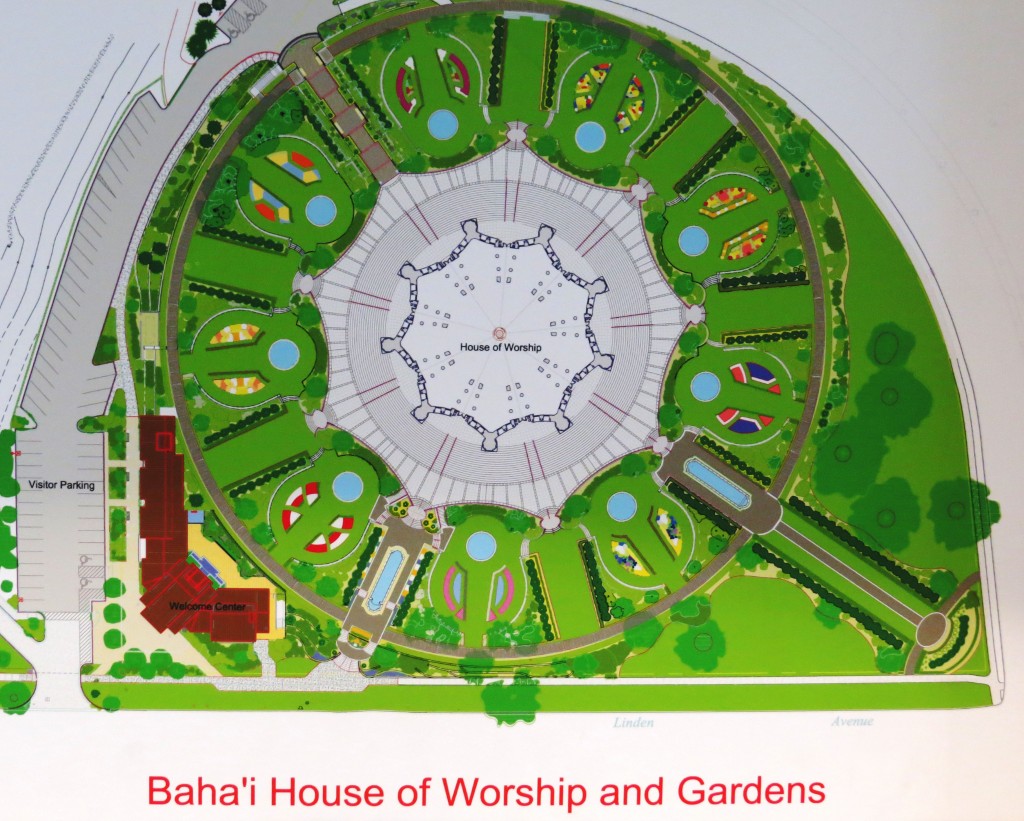Bahá’í House of Worship
Exterior -Bahá’í House of Worship
On the shores of Lake Michigan, not far from where the North Canal meets the harbor at the Chicago suburb of Wilmette, stands the architecturally unique Bahá’í House of Worship. How it came to be built in the heart of the United States is a story that begins with the Worlds Columbian Exposition in 1893. Inspired by news of the first Bahá’í Temple in Ashgabat, Turkmenistan, members of the Chicago Bahá’í House of Spirituality drafted a petition in 1903 asking permission to begin their own. Fifty years later, in 1953, a completed Bahá’í House of Worship was dedicated in Wilmette. For those living in Chicago land, it is known as the Bahá’í Temple, the site of a thousand field trips, a short walk through lovely gardens, an uplifting place of silent prayer and meditation. In 1978, the House of Worship was added to the National Register of Historic Places and in 2008 one of the Seven Wonders of Illinois.
The Bahá’í Faith is an independent religion practiced throughout the world by more than 5 million people of nearly every nationality and ethnic background. They are attracted to the faith by the belief that we all belong to one human race, which all religions share a common source and aim…that the long awaited era of peace promised by God in the world’s sacred scriptures is now within reach. Its sole purpose is to provide a place of prayer and meditation for anyone who wishes to do either. The auditorium is open all the way to the top of the dome with sunlight streaming through hundreds of windows to a shining red terrazzo floor filled with chairs. There is a no clergy in the Bahá’í Faith. No sermons or speeches are made during devotional programs in the Bahá’í House of Worship’s auditorium, only recitations of verses from the Bahá’í writings and scriptures from other faiths, including the Bible, Quran, Upanishads and others. Within the sparkling exterior concrete ornamental panels one can observe all the artistry of Louis Bourgeois, a Canadian architect who came to Chicago and worked with Louis Sullivan and the sculptor John J. Earley of the Earley Studio in Washington, DC.
Transforming Bourgeois’ drawings, some requiring 109-foot long sheets of paper, into double ornamentation resulted in an innovative process of lasting concrete panels composed of quartz crystal and white cement to form the temple’s intricate, lacy exterior. Hundreds of precisely sized and fitted sections were hung on the temple’s steel superstructure. The symmetry of the Bahá’í House of Worship was surely influenced by the École Des Beaux Arts.
The dome is early Renaissance, with an arabesque tracery common in Islamic architecture. The ribs could be called Gothic, the clearstory suggestive of Romanesque and the arches over the windows look 8th century Moorish Spain. The ribs of the Temple symbolize the hands of the people of all religions clasped together in prayer. The pillars are reminiscent of the minarets of great Muslim mosques. Symbols of many religions, such as the Christian cross, the Star of David and the star and crescent can be found on each exterior pillar. The pillars are
also decorated with a symbol used by Hindus and Buddhists in the form of a Swastika. At the top of each pillar is a nine-pointed star symbolizing the Bahá’í Faith. In the panels directly above the nine doors, decorated letters, ABHA, of a word can be found. It is the Arabic word for glory; the word is also integral to the name of the prophet-founder of the Bahá’í Faith, Bahá’u’lláh. It is also an expression of the number nine. When the numbers representing the letters in Abha are added together according to the traditional Abjad numbering system they total nine (1+2+5+1). Numbers as representatives of spiritual concepts have a rich tradition in Islamic culture and nine is the highest number symbolizing perfection, unity and comprehensiveness. This is why a Bahá’í House of Worship feature nine sides, doors and gardens.
The Bahá’í House of Worship and gardens form a single, sacred space where all the people are invited to pray to God and meditate in an atmosphere of beauty and light. In the Bahá’í




